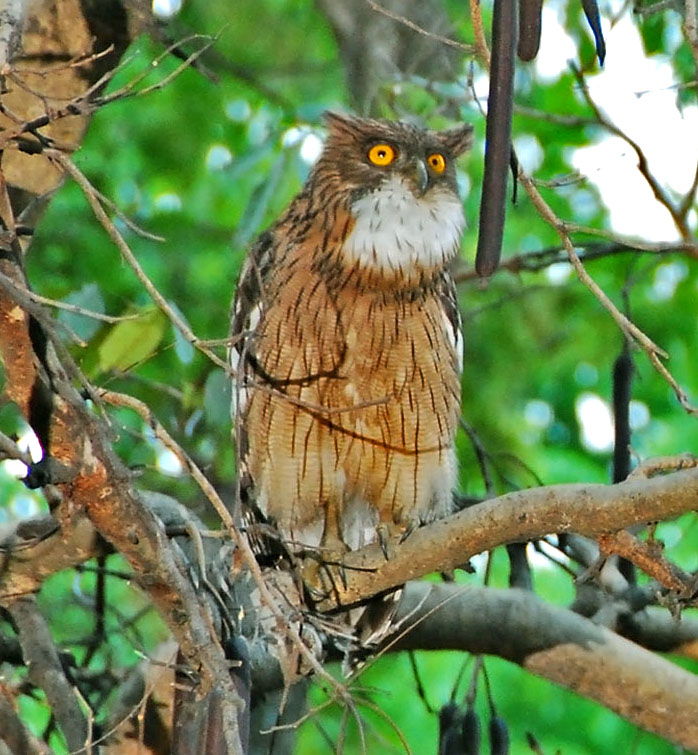- Brown Fish-owl
Taxobox
name = Brown Fish Owl
status = LR/lc

regnum =Animal ia
phylum =Chordata
classis =Aves
ordo =Strigiformes
familia =Strigidae
genus = "Bubo" (but see text)
species = "B. zeylonensis"
binomial = "Bubo zeylonensis"
binomial_authority = (Gmelin, 1788)
subdivision_ranks =Subspecies
subdivision =
* "B. z. zeylonensis" Taxobox_authority | author = (Gmelin | date = 1788) Sri Lankan Brown Fish-owl
* "B. z. leschenault" Taxobox_authority | author = (Temminck | date = 1820) Common Brown Fish-owl
* "B. z. semenowi" Taxobox_authority | author = Zarudny | date = 1905 Western Brown Fish-owl
* "B. z. orientalis" Taxobox_authority | author = Delacour | date = 1926 Eastern Brown Fish-owl (disputed)and see text
synonyms ="Strix zeylonensis" Gmelin, 1788 "Ophthalmomegas lamarmorae" Dejaut, 1911 and see textThe Brown Fish Owl, "Bubo zeylonensis" or "Ketupa zeylonensis", is an
owl . Thisspecies is a part of the family known astypical owl s, Strigidae, which contains most species of owl. The Brown Fish Owl and three related species were previously placed in the genus "Ketupa";mtDNA cytochrome "b" sequence data is equivocal on which genus name is applied for this species (Olsen "et al." 2002).This is a large (55cm) owl. The upperparts are reddish brown, heavily streaked with black or dark brown. The underparts are buff with brown streaking. The throat is white. The eyes are yellow, and there are prominent "ears". Sexes are similar.
This species is a resident breeder in most of tropical south
Asia from thePakistan to southChina ; west of its main range, it is patchily distributed to the northernLevant . Its habitat is open wooded country, lowland forest and plantations, always near water.In prehistoric times, this species was apparently present all over the central and easternMediterranean basin. These birds differed in size and have been separated aspaleosubspecies "B. z. lamarmorae" (Dejaut, 1911). They are known from (probably) theEarly Pliocene onwards (c.5 mya); at the onset of thelast ice age , this population disappeared from the western part of its range, while the easternmost populations were probably subsumed in thegene pool of "semenowi" (Mlíkovský, 2003). TheLate Miocene - Early Pliocenetaxon "Strix" perpasta" and theLate Pleistocene "Bubo insularis" are considered to bejunior synonym s of the paleosubspecies by some (Mlíkovský, 2002).It lays one or two eggs, often in the old stick nest of other birds, or in a rock crevice. Incubation is up to 38 days, and the young fledge after about 7 weeks.
This species is very nocturnal but it can often be located by the small birds that mob it while it is roosting in a tree. It feeds mainly on fish and frogs. Its calls are described as a deep "tu-hoo-hoo" [http://www.owls.org/Species/bubo/brown_fish_owl.htm] or a soft huphuphuphuphuphup or a loud huhuhuhuhuhuhu.
References
* Grimmett, Richard; Inskipp, Carol, Inskipp, Tim & Byers, Clive (1999): "Birds of India, Pakistan, Nepal, Bangladesh, Bhutan, Sri Lanka, and the Maldives". Princeton University Press, Princeton, N.J.. ISBN 0-691-04910-6
* Mlíkovský, Jirí (2002): "Cenozoic Birds of the World, Part 1: Europe". Ninox Press, Prague. ISBN 80-901105-3-8 [http://www.nm.cz/download/JML-18-2002-CBE.pdf PDF fulltext]
* Mlíkovský, Jirí (2003): Brown Fish Owl ("Bubo zeylonensis") in Europe: past distribution and taxonomic status. "Buteo" 13: 61-65. [http://www.nm.cz/download/JML-13-2003-bubo-zeylonensis.pdf PDF fulltext]
* Olsen, Jery; Wink, Michael; Sauer-Gürth, Heidi & Trost, Susan (2002): A new "Ninox" owl from Sumba, Indonesia. "Emu" 102(3): 223-231. DOI|10.1071/MU02006 [http://www.uni-heidelberg.de/institute/fak14/ipmb/phazb/pdf-files/2002%20Pdf.Pubwink/17.2002.pdf PDF fulltext]
* [http://www.iucnredlist.org/search/details.php/48537/summ 2007 IUCN Red List]
Wikimedia Foundation. 2010.
